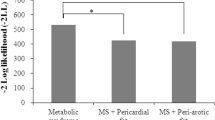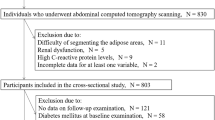Summary
Objective
To evaluate thoracic periaortic adipose tissue (TAT) burden in patients with type 2 diabetes mellitus (DM) in comparison with controls and in relation to cardiovascular risk factors.
Methods
A total of 93 patients with type 2 DM (mean (standard deviation; SD) age: 56.7 (11.2) years, 71.0 % were men) and 85 nondiabetic control subjects (mean (SD) age: 54.6 (10.9) years, 58.8 % were men) who were admitted to Mevlana University hospital between January 2011 and June 2013 and underwent multidetector computed tomography for any reason were included in this retrospective cohort study. Patient and control groups were compared in terms of demographic characteristics, anthropometrics, and laboratory findings. TAT volume was evaluated in both groups, while correlates of TAT were determined via linear regression analysis among patients.
Results
In patients with type 2 DM, TAT volume (40.1 (23.9) versus 16.9 (7.7) cm3, p < 0.001), fasting blood glucose (p < 0.001), total cholesterol (p < 0.001), triglyceride (p = 0.017), and low-density lipoprotein (LDL) cholesterol (p = 0.034) levels were significantly higher compared with the control group. Strong positive correlation of TAT was noted with body mass index (r = 0.339, p = 0.001) and serum levels for fasting blood glucose (r = 0.343, p < 0.001), hemoglobin A1c (HbA1c; r = 0.615, p < 0.001), total cholesterol (r = 0.269, p = 0.009), and LDL cholesterol (r = 0.258, p = 0.013). In stepwise regression analysis, Hba1c emerged as a significant predictor of TAT (b = 0.610, p < 0.001), contributing to 19 % of its variability.
Conclusion
In conclusion, our findings indicate significantly higher values for TAT in diabetics than controls, being associated positively with body weight, poor glycemic control, and dyslipidemia and strongly predicted by HbA1c levels in diabetic patients, while not differing with respect to gender, smoking status, and concomitant hypertension.
Zusammenfassung
Ziel
Auswertung des Ausmaßes von thorakalem periaortalem Fettgewebe (TPF) bei Patienten mit Typ 2 Diabetes mellitus im Vergleich zu Kontrollen und im Zusammenhang mit kardiovaskulären Risikofaktoren.
Methoden
Insgesamt wurden 93 Patienten mit Typ 2 Diabetes mellitus (Mittleres (SD) Alter 56,7 (11,2) Jahre, 71,0 % Männer) und 85 Kontrollpersonen ohne Diabetes mellitus (Mittleres (SD) Alter: 54,6 (10,9) Jahre, 58,8 % Männer), die dem Mevlana Universitäts-Spital zwischen Jänner 2011 und Juni 2013 zugewiesen worden waren und bei denen, aus welchem Grund auch immer, eine Multidetektor Computer Tomographie durchgeführt worden war, in diese retrospektive Kohortenstudie aufgenommen. Die Patienten und Kontrollpersonen wurden bezüglich demographischer und anthropometrischer Charakteristika, sowie Laborergebnissen verglichen. Das TPF wurde bei beiden Gruppen erhoben und mögliche Korrelationen mittels linearer Regressions Analyse errechnet.
Ergebnisse
Bei Patienten mit Typ 2 Diabetes mellitus. war das TPF Volumen 40,1 (23,9) cm3 vs. 16,9 (7,7) cm3, p < 0,001), der Nüchternblutzucker (p < 0,001), das Gesamt-Cholesterin (p < 0,001), die Triglyceride (p = 0,017), und das LDL-Cholesterin (p = 0,034) im Vergleich zur Kontrolle signifikant höher. Das TPF war besonders positiv mit dem Body Mass Index (r = 0,339; p = 0,001), dem Nüchternblutzucker (r = 0,343; p < 0,001), dem Hämoglobin A1c (HbA1c) (r = 0,615; p < 0,001), dem Gesamt Cholesterin (r = 0,269; p = 0,009) und dem LDL-Cholesterin (r = 0,258; p = 0,013) korreliert. Die stufenweise Regressionsanalyse ergab, dass das HbA1c ein signifikanter Prädiktor des TPF (b = 0,610, p < 0,001) war, und 19 % zu seiner Variabilität beitrug.
Schlussfolgerung
Unsere Ergebnisse zeigen, dass das TPF bei Patienten mit Typ Diabetes mellitus signifikant höher ist als bei Kontrollen ohne Diabetes mellitus. Das TPF ist signifikant positiv mit dem Körpergewicht und mit schlechter Kontrolle der Glykämie und Dyslipidämie korreliert und kann bei Diabetikern deutlich vom HbA1c vorhergesagt werden. Es besteht keine Korrelation zum Geschlecht, Raucherstatus und eventueller begleitender Hypertonie.
Similar content being viewed by others
References
Wild S, Roglic G, Green A, Sicree R, King H. Global prevalence of diabetes: estimates for the year 2000 and projections for 2030. Diabetes Care. 2004;27:1047–53.
Clarke PM, Gray AM, Briggs A, Farmer AJ, Fenn P, Stevens RJ, Matthews DR, Stratton IM, Holman RR. A model to estimate the lifetime health outcomes of patients with type 2 diabetes: the United Kingdom Prospective Diabetes Study (UKPDS) Outcomes Model (UKPDS no. 68). Diabetologia. 2004;47:1747–59.
Haffner SM, Lehto S, Rönnemaa T, Pyörälä K, Laakso M. Mortality from coronary heart disease in subjects with type 2 diabetes and in nondiabetic subjects with and without prior myocardial infarction. N Engl J Med. 1998;339:229–34.
Kannel WB, McGee D, Gordon T. A general cardiovascular risk profile: the Framingham Study. Am J Cardiol. 1976;38:46–51.
Yang FS, Yun CH, Wu TH, Hsieh YC, Bezerra HG, Liu CC, Wu YJ, Kuo JY, Hung CL, Hou CJ, Yeh HI, Lee JJ, Bulwer BE, Cury RC. High pericardial and peri-aortic adipose tissue burden in pre-diabetic and diabetic subjects. BMC Cardiovasc Disord. 2013;13:98.
Yun CH, Lin TY, Wu YJ, Liu CC, Kuo JY, et al. Pericardial and thoracic peri-aortic adipose tissues contribute to systemic inflammation and calcified coronary atherosclerosis independent of body fat composition, anthropometric measures and traditional cardiovascular risks. Eur J Radiol. 2012;81:749–56.
Mahabadi AA, Massaro JM, Rosito GA, Levy D, Murabito JM, et al. Association of pericardial fat, intrathoracic fat, and visceral abdominal fat with cardiovascular disease burden: the Framingham Heart Study. Eur Heart J. 2009;30:850–6.
Lehman SJ, Massaro JM, Schlett CL, O’Donnell CJ, Hoffmann U, Fox CS. Periaortic fat, cardiovascular disease risk factors, and aortic calcification: the Framingham Heart Study. Atherosclerosis. 2010;210:656–61.
Chatterjee TK, Stoll LL, Denning GM, Harrelson A, Blomkalns AL, Idelman G, Rothenberg FG, Naltner B, Romig-Martin SA, Dickson EW, Rudich S, Weintraub NL. Proinflammatory phenyotype of perivascular adipocytes: influence of high-fat feeding. Circ Res. 2009;104:541–9.
Cassis LA, Lynch KR, Peach MJ. Localization of angiotensinogen messenger RNA in rat aorta. Circ Res. 1988;62:1259–62.
Barandier C, Montani JP, Yang Z. Mature adiposites and perivascular adipose tissue stimulate vascular smooth muscle cell proliferation: effects of aging and obesity. Am J Physiol Heart Circ Physiol. 2005;289:H1807–13.
Fox CS, Massaro JM, Schlett CL, Lehman SJ, Meigs JB, O’Donnell CJ, Hoffmann U, Murabito JM. Peri-aortic fat deposition is associated with peripheral arterial disease: the Framingham Heart Study. Circ Cardiovasc Imaging. 2010;3:515–9.
Kaess BM, Pedley A, Massaro JM, Larson MG, Corsini E, Hoffmann U, Smith HM, Sawyer DB, Vasan RS, Fox CS. Relation of vascular growth factors with CT-derived measures of body fat distribution: the Framingham Heart Study. J Clin Endocrinol Metab. 2012;97(3):987–94. doi:10.1210/jc.2011-2310.
Britton KA, Pedley A, Massaro JM, Corsini EM, Murabito JM, Hoffmann U, Fox CS. Prevalence, distribution, and risk factor correlates of high thoracic periaortic fat in the Framingham Heart Study. J Am Heart Assoc. 2012;1(6):e004200. doi:10.1161/JAHA.112.004200.
Thanassoulis G, Massaro JM, Corsini E, Rogers I, Schlett CL, Meigs JB, Hoffmann U, O’Donnell CJ, Fox CS. Periaortic adipose tissue and aortic dimensions in the Framingham Heart Study. J Am Heart Assoc. 2012;1(6):e000885. doi:10.1161/JAHA.112.000885.
Yun CH, Bezerra HG, Wu TH, Yang FS, Liu CC, Wu YJ, Kuo JY, Hung CL, Lee JJ, Hou CJ, Yeh HI, Longenecker CT, Cury RC. The normal limits, subclinical significance, related metabolic derangements and distinct biological effects of body site-specific adiposity in relatively healthy population. PLoS One. 2013;8(4):e61997.
Wang CP, Hsu HL, Hung WC, Yu TH, Chen YH, Chiu CA, Lu LF, Chung FM, Shin SJ, Lee YJ. Increased epicardial adipose tissue (EAT) volume in type 2 diabetes mellitus and association with metabolic syndrome and severity of coronary atherosclerosis. Clin Endocrinol (Oxf). 2009;70(6):876–82.
Iacobellis G, Barbaro G, Gerstein HC. Relationship of epicardial fat thickness and fasting glucose. Int J Cardiol. 2008;128(3):424–6.
Schlett CL, Massaro JM, Lehman SJ, Bamberg F, O’Donnell CJ, Fox CS, Hoffmann U. Novel measurement of periaortic adipose tissue in comparison to anthropometric measures of obesity, and abdominal adipose tissue. Int J Obes. 2009;33:226–32.
Mansour AA, Ajeel NA. Atherosclerotic cardiovascular disease among patients with type 2 diabetes in Basrah. World J Diabetes. 2013;4(3):82–7.
Taleb N, Salti H, Al-Mokaddam M, Merheb M, Salti I, Nasrallah M. Prevalence and determinants of albuminuria in a cohort of diabetic patients in Lebanon. Ann Saudi Med. 2008;28:420–5. doi:10.4103/0256-4947.51674. PMID: 19011313.
Jurado J, Ybarra J, Solanas P, Caula J, Gich I, Pou JM, Romeo JH. Prevalence of cardiovascular disease and risk factors in a type 2 diabetic population of the North Catalonia diabetes study. J Am Acad Nurse Pract. 2009;21:140–8.
Abdel-Aal NM, Ahmad AT, Froelicher ES, Batieha AM, Hamza MM, Ajlouni KM. Prevalence of dyslipidemia in patients with type 2 diabetes in Jordan. Saudi Med J. 2008;29:1423–8.
Després JP, Lemieux I. Abdominal obesity and metabolic syndrome. Nature. 2006;444(7121):881–7.
Yusuf S, Hawken S, Ounpuu S, Bautista L, Franzosi MG, Commerford P, Lang CC, Rumboldt Z, Onen CL, Lisheng L, Tanomsup S, Wangai P, Jr., Razak F, Sharma AM, Anand SS, INTERHEART Study Investigators. Obesity and the risk of myocardial infarction in 27,000 participants from 52 countries: a case-control study. Lancet. 2005;366(9497):1640–9.
Yudkin JS, Eringa E, Stehouwer CDA. “Vasocrine” signalling from perivascular fat: a mechanism linking insulin resistance to vascular disease. Lancet. 2005;365:1817–20.
Greenstein AS, Khavandi K, Withers SB, Sonoyama K, Clancy O, Jeziorska M, Laing I, Yates AP, Pemberton PW, Malik RA, Heagerty AM. Local inflammation and hypoxia abolish the protective anticontractile properties of perivascular fat in obese patients. Circulation. 2009;119:1661–70.
Soltis E, Cassis L. Influence of perivascular adipose tissue on rat aortic smooth muscle responsiveness. Clin Exp Hypertens A. 1991;13:277–96.
Eringa EC, Bakker W, Smulders YM, Serné EH, Yudkin JS, Stehouwer CDA. Regulation of vascular function and insulin sensitivity by adipose tissue: focus on perivascular adipose tissue. Microcirculation. 2007;14:389–402.
Pi-Sunyer FX. The epidemiology of central fat distribution in relation to disease. Nutr Rev. 2004;62(7 Pt. 2):S120–6.
Despres JP, Lemieux I, Prud’homme D. Treatment of obesity: need to focus on high risk abdominally obese patients. BMJ. 2001;322(7288):716–20.
Mazurek T, Zhang L, Zalewski A, Mannion JD, Diehl JT, Arafat H, Sarov-Blat L, O’Brien S, Keiper EA, Johnson AG, et al. Human epicardial adipose tissue is a source of inflammatory mediators. Circulation. 2003;108(20):2460–6.
Britton KA, Wang N, Palmisano J, Corsini E, Schlett CL, Hoffmann U, Larson MG, Vasan RS, Vita JA, Mitchell GF, Benjamin EJ, Hamburg NM, Fox CS. Thoracic periaortic and visceral adipose tissue and their cross-sectional associations with measures of vascular function. Obesity (Silver Spring). 2013;21(7):1496–503.
Selvin E, Marinopoulos S, Berkenblit G, Rami T, Brancati FL, Powe NR, Golden SH. Meta-analysis: glycosylated hemoglobin and cardiovascular disease in diabetes mellitus. Ann Intern Med. 2004;141:421–31.
Ruderman NB, Schneider SH, Berchtold P. The “Metabolically-obese”, normalweight individual. Am J Clin Nutr. 1981;34:1617–21.
Ruderman N, Chisholm D, Pi-Sunyer X, Schneider S. The metabolically obese, normal-weight individual revisited. Diabetes. 1998;47:699–713.
Author information
Authors and Affiliations
Corresponding author
Rights and permissions
About this article
Cite this article
Akyürek, Ö., Efe, D. & Kaya, Z. Thoracic periaortic adipose tissue in relation to cardiovascular risk in type 2 diabetes mellitus. Wien Klin Wochenschr 126, 767–773 (2014). https://doi.org/10.1007/s00508-014-0611-8
Received:
Accepted:
Published:
Issue Date:
DOI: https://doi.org/10.1007/s00508-014-0611-8




